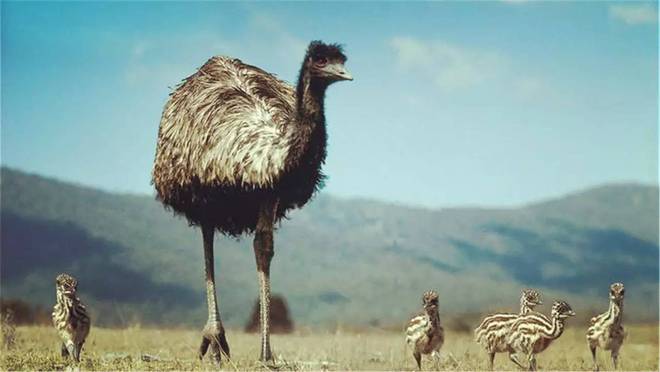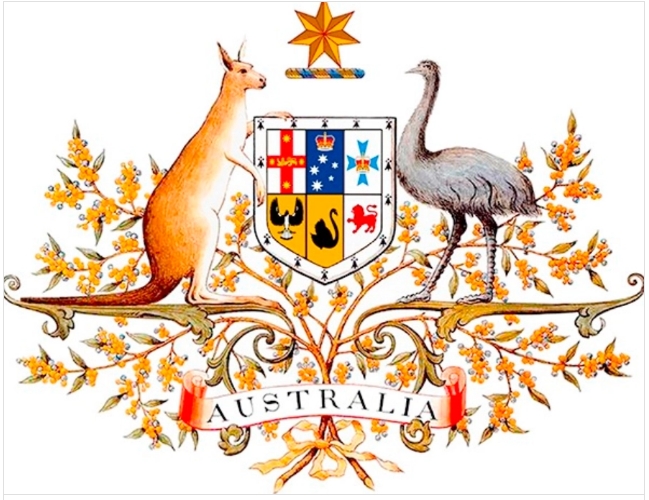Dromaius novaehollandiae
IUCN
LCBasic Information
Scientific classification
- name:Dromaius novaehollandiae
- Scientific Name:Emu,Dromaius ater, Dromaius novaehollandiae rothschild,Australian ostrich, Ostrich australis,cassowary
- Outline:Landfowl
- Family:D.novaehollandiae Dromaius Dromaiidae Casuariiformes Aves
Vital signs
- length:2.1m
- Weight:30-45kg
- lifetime:10~30years
Feature
Fossil period: Miocene to present, the second largest bird in the world
Distribution and Habitat
Native to Australia, it grows in sandy grasslands and open forests.
Appearance
Flat bill, long neck, bare upper neck skin that is grey-blue, sparse feathers on the lower neck. Feathers are soft, ranging in colour from grey-brown to black, wings are very small and barely visible, legs are long, feet are scaly, have three toes and no hind toes.
Details

Emu (scientific name: Dromaius novaehollandiae, pronounced the same as "ermiao"), also known as Australian ostrich, Australian ostrich, is the only species of the genus Emu. The fossil period is from the Miocene to the present. It is the second largest bird in the world, second only to the ostrich. It is 2.1 meters long, 15-18.5 meters tall, weighs 30-45 kilograms, and has a lifespan of 10 years. It is famous for its running skills. It can run up to 69 kilometers per hour and each stride can reach 3 meters. When trapped, it kicks people with its three-toed big feet. It is a flightless bird and a specialty of Oceania. Since it is only distributed in Australia, it is one of the animals on the Australian national emblem.
It is a flat-chested bird with no keel, a short and flat beak, blue exposed skin on the neck, a gray beak, a flat beak, a long neck, exposed upper neck skin, and sparse feathers on the lower neck. The skin of the head and neck is gray-blue with short black coarse feathers. Feathers are soft, grey, brown or black, long and curly, covering the sides of the body from the neck. Feathers are underdeveloped, with fine drooping feathers, and well-developed secondary feathers. There are feathers on the head and neck, but no wattles. The wings are very small and hidden under the body feathers. The wings are degenerate and completely unable to fly. The remaining wings are about 20 cm long. There is a small bump on the top of each wing. The wings are rough and have drooping feathers. Their feathers are fluffy near the body and sparse at the tip. This growth can block the heat of the sun and prevent overheating during daytime activities. Legs are long, with scaly skin on the feet, three toes, no hind toes, and all three toes have blunt claws. These characteristics of the emu make it similar to the ostrich in appearance, but relatively small in size.
Emu inhabits sandy grasslands and relatively open forests. The main habitat types are sclerophyll forests and savanna woodlands. They rarely appear in tropical rainforests or very arid areas. Their habitat is usually below 1600 meters above sea level. They are also good swimmers and can easily cross rivers. They have a unique talent and instinctively seek out shallow water areas when crossing rivers.
In hot weather, emus will stick out their tongues and pant like dogs, breathing rapidly and cooling down by evaporating water from their lungs. They can pant all day without being affected by low blood carbon dioxide levels, but they must drink water every day to replenish body fluids. In cool weather, they breathe normally. The multiple wrinkles in the nasal passages warm the cool air they inhale and take away the heat from the nose. When they exhale, the cooler nasal conchae condense water for reabsorption.
Communicate through sound. Its call is similar to "e-moo", which is emitted through a flat throat sac. The sound is high-pitched and can be transmitted up to 2 kilometers. It can live in an environment of -5℃~45℃, and the optimal living temperature is 10℃~30°C. The basal metabolic rate of the emu is relatively low. At −5°C, its metabolic rate when sitting is about 60% of that when standing. This is mainly because when standing, the emu loses more heat from its abdomen, which is not protected by feathers.
Emus migrate in groups, and their migration depends on the season: they go north in summer and south in winter; but the migration of eastern emus is much more random. Emus normally walk 10 to 25 kilometers a day, so it is normal to migrate 1,000 kilometers per season.
As a diurnal bird, it begins to rest after sunset. When the emu's neck hangs close to the body, the eyelids are closed, and there is no interference from the external environment, it will enter a deep sleep state after about 20 minutes. The emu's body gradually descends until it touches the ground, the legs are folded under the body, the beak is turned down, and the neck is bent into an S shape, close to the body. Young emus usually sleep in a supine position, with the neck and legs stretched along the ground.
The daily food is a variety of fruits, seeds, grains, flowers, fruits, sprouts, insects, larvae or any edible plants. In spring and autumn, they get most of their food from bushes and also prey on some insects, while in autumn and winter, they get most of their food from annual plants. The length of the emu's small intestine is about 3.5 meters, with an enlarged ileum and well-developed blood vessels on the intestinal wall, which is the main place for digestion and absorption. To help digestion, they will also swallow small stones. Although emus often eat farmers' crops, Australian farmers love and hate them because they also like to eat insects on crops, which makes crops grow better.

"One wife and one husband" multiple mating, a pair occupies an area of about 30 square kilometers and lives together for about five months. After the weather cools down, the hormones in the male emu change, the appetite decreases, and it begins to build a nest on the ground with branches, leaves, bark and grass. The nest is platform-shaped. Once the female attracts the male's attention, she will walk around the male at a distance of 10 to 40 meters and turn her neck to look at the male.
Adult female birds only lay eggs from November to April of the following year. The male and female emu mate every one or two days, and the sperm produced by mating is enough to fertilize about six eggs. Each female bird lays 9 to 12 eggs. After mating, the emu will lay dark green eggs. The eggshell is very thick and weighs about 550 to 600 grams. After about seven eggs are laid, the responsibility of incubation is assumed by the male bird. The male emu begins to sit on the eggs to incubate them. The incubation temperature is 33 to 35 degrees Celsius, which is slightly lower than that of ordinary birds.
From then on, the male emu does not eat or drink, and only stands up about 10 times a day when it needs to turn the eggs. For about 8 weeks, it survives on the fat in its body and only drinks a little morning dew every day. During the incubation period, the male bird will lose about one-third of its weight. The incubation period takes 8 weeks, during which the male will not leave the nest. After hatching, the male will protect the flock and teach the chicks how to hunt. During this period, male emus remain aggressive towards other emus, even female emus. The nursing period lasts up to 7 months. The chicks will follow their father for two years after birth.
After the chicks hatch, they are still cared for by the father for nearly 2 months. Although there are male emus who stick to the nest, emu eggs are still often stolen, especially by monitor lizards. Emu chicks have vertical stripes that help them camouflage. Emus are precocial chicks. Newly hatched birds are very active and can leave the nest after a few days. They are about 25 cm tall at first, with brown and yellow stripes on their bodies. After 3 months, the stripes fade and disappear. The father emu raises them for at least 6 months. Young emus grow very fast (up to one kilogram a week) and become adult birds after 12 to 14 months. Many of them continue to live with their parents for 6 months, and then separate to raise the second generation.
Growth of young birds
The average birth weight of chicks is 500 grams. The chicks have milky white down feathers with brown vertical stripes and brown spots on their heads. Emus leave the flock at 15 to 18 months old and reach sexual maturity at 2 to 3 years old. Their lifespan is generally 10 to 30 years, and can reach 30 years in captivity; in the wild, their lifespan will be shortened.

The emu is known as the "national bird" of Australia and is one of the "guardian beasts" on the Australian national emblem. Its image is inlaid on the national emblem of Australia.







